
There are a variety of computational formulations of retinex but it is the center/surround convolutional variant that is of interest to us here. In convolutional retinex, an image is filtered by a center/surround operator that is to designed to mitigate the effects of shading, which in turn compresses the dynamic range. The parameters that define the shape and extent of these filters are tuned to give the “best” results. In their 1988 paper, Hurlbert & Poggio showed that the problem can be formulated as a regression, where corresponding pairs of images with and without the effects of shading are related by a center/surround convolution filter that is found by solving an optimization. This paper starts with the observation that finding sufficiently large representative pairs of images with and without shading is difficult. This leads us to reformulate the Hurlbert & Poggio approach so that we analytically integrate over the whole sets of shadings and albedos, which means that no sampling is required. Rather nicely, the derived filters are found in closed form and have a smooth shape, unlike the filters derived by the prior art. Experiments validate our method.